
FACULTY OF ARTS AND SCIENCES
Department of English Translation and Interpreting
İMT 320 | Course Introduction and Application Information
| Course Name |
Introduction to Audio Description
|
|
Code
|
Semester
|
Theory
(hour/week) |
Application/Lab
(hour/week) |
Local Credits
|
ECTS
|
|
İMT 320
|
Fall/Spring
|
3
|
0
|
3
|
4
|
| Prerequisites |
None
|
|||||
| Course Language |
Turkish
|
|||||
| Course Type |
Elective
|
|||||
| Course Level |
First Cycle
|
|||||
| Mode of Delivery | face to face | |||||
| Teaching Methods and Techniques of the Course | Q&ACritical feedbackApplication: Experiment / Laboratory / WorkshopLecture / Presentation | |||||
| Course Coordinator | ||||||
| Course Lecturer(s) | - | |||||
| Assistant(s) | - | |||||
| Course Objectives | The aim of this course is to introduce audio description to the students, raising their awareness in terms of the importance and necessity of audio description and equipping them with audio description rules of different fields such as cinema, theatre, museums, and paintings. In addition to audio description literacy, this course aims to make the students aware of the fact that disability is a difference in abilities and audio description should be accepted as a right. |
| Learning Outcomes |
The students who succeeded in this course;
|
| Course Description | This course is based on practice as well as theoretical knowledge. The students will be introduced to the notion of audio description firstly, and they will learn the rules of audio description through practice at a slow rate. While doing so, students will comprehend general principles such as complementariness, objectivity, placing the description at the right moment. |
|
|
Core Courses | |
| Major Area Courses | ||
| Supportive Courses | ||
| Media and Management Skills Courses | ||
| Transferable Skill Courses |
X
|
WEEKLY SUBJECTS AND RELATED PREPARATION STUDIES
| Week | Subjects | Related Preparation |
| 1 | What is Disability? What do the disabled need? Introduction to the importance of description in the lives of the disabled | Okyayuz, A. Ş. (2017). Sesli betimlemenin çeviribilim sınıflarında tanıtımı için bir eğitim bileşeni önerisi. Turkish Studies, 12 (22), 559-586. DOI: 10.7827/TurkishStudies |
| 2 | What is description? Introducing the basics: complementariness, objectivity and arrangement | Maszerowska, A., Matamala, A., & Orero, P. (2014). From source text to target text: the art of audio description. In Maszerowska, A., Matamala, A., & Orero, P. (Eds), Audio description: New perspectives illustrated (pp. 1-10). Amsterdam, Philadelphia: John Benjamins. ISBN: 9789027269423. |
| 3 | Types of description in different fields such as cinema, theatre, painting and sculpture and their differences | Baş, N. (2019). Görenler sesli betimlenmiş bir filmi nasıl anlar? Sesli betimleme ile ilgili bir alımlama çalışması denemesi. Çeviribilim ve Uygulamaları, 26, 37-59. DOI: 10.37599/ceviri.518756 |
| 4 | Introduction to description writing: The 5 Ws and 1H | Fryer, L., Romero-Fresco, P. (2014). Audiointroductions. In Maszerowska, A., Matamala, A., & Orero, P. (Eds), Audio Description: New perspectives illustrated (pp. 11-29). Amsterdam, Philadelphia: John Benjamins. ISBN: 9789027269423. |
| 5 | Writing sample texts about the 5 Ws and 1H of description and discussing them | Fryer, L., Romero-Fresco, P. (2014). Audiointroductions. In Maszerowska, A., Matamala, A., & Orero, P. (Eds), Audio description: New perspectives illustrated (pp. 11-29). Amsterdam, Philadelphia: John Benjamins. ISBN: 9789027269423. |
| 6 | Style and Word choice in description | Maszerowska, A., Mangiron, C. (2014). Strategies for dealing with cultural references in audio descrpition. In Maszerowska, A., Matamala, A., & Orero, P. (Eds), Audio description: New perspective illustrated (pp. 159-179). Amsterdam, Philadelphia: John Benjamins. ISBN: 9789027269423. |
| 7 | Wording body language and movements in description | Güven, M. (2018). Sesli betimleme araştırmalarında güncel yönelimler. Dilbilim Araştırmaları Dergisi, 29 (2), 107-127. DOI: 10.18492/dad.424635 |
| 8 | Describing visuals without video content and interpreting the rules accordingly | Orero, P., Vilero, A. (2014). Secondary elements in audio description. In Maszerowska, A., Matamala, A., & Orero, P. (Eds), Audio description: New perspectives iIlustrated (pp. 199-213). Amsterdam, Philadelphia: John Benjamins. ISBN: 9789027269423. |
| 9 | Simultaneous description: simultaneous description of performing arts such as theatre and ballet. | Güven, M. (2018). Sesli betimleme araştırmalarında güncel yönelimler. Dilbilim Araştırmaları Dergisi, 29 (2), 107-127. DOI: 10.18492/dad.424635 |
| 10 | Introduction to description of video content such as cinema. Creating a text by using description software | Kökat, S. (2018). Bir kamusal alana çıkma pratiği: Sinema deneyimi ve hikayeleme aracı olarak sesli betimleme yöntemi. Ege Üniversitesi İletişim Fakültesi Yeni Düşünceler Hakemli E-Dergisi, 5-15. |
| 11 | Describing display elements (logos, lyrics, subtitles, screen credits) | Matamala, A. (2014). Audio describing text on screen. In Maszerowska, A., Matamala, A., & Orero, P. (Eds), Audio description: New perspectives illustrated (pp. 103-121). Amsterdam, Philadelphia: John Benjamins. ISBN: 9789027269423. |
| 12 | Importance and evaluation of montage and dubbing in videos | Vercauteren, G., Remael, A. (2014). Spatio-temporal setting. In Maszerowska, A., Matamala, A., & Orero, P. (Eds), Audio description: New perspectives illustrated (pp. 61-80). Amsterdam, Philadelphia: John Benjamins. ISBN: 9789027269423. |
| 13 | Comparing different description schools in video description | Perego, E. (2014). Film and language tools. In Maszerowska, A., Matamala, A., & Orero, P. (Eds), Audio description: New perspectives illustrated (pp. 81-103). Amsterdam, Philadelphia: John Benjamins. ISBN: 9789027269423. |
| 14 | Final projects and presentations | Student presentations |
| 15 | Review of Semester | |
| 16 | Final Exam |
| Course Notes/Textbooks | Baş, N. (2019). Görenler sesli betimlenmiş bir filmi nasıl anlar? Sesli betimleme ile ilgili bir alımlama çalışması denemesi. Çeviribilim ve Uygulamaları, 26, 37-59. DOI: 10.37599/ceviri.518756. Güven, M. (2018). Sesli betimleme araştırmalarında güncel yönelimler. Dilbilim Araştırmaları Dergisi, 29 (2), 107-127. DOI: 10.18492/dad.424635. Kökat, S. (2018). Bir kamusal alana çıkma pratiği: Sinema deneyimi ve hikayeleme aracı olarak sesli betimleme yöntemi. Ege Üniversitesi İletişim Fakültesi Yeni Düşünceler Hakemli E-Dergisi, 5-15. Maszerowska, A., Matamala, A., & Orero, P. (2014). Audio description: New perspectives illustrated. Amsterdam, Philadelphia: John Benjamins. ISBN: 9789027269423. Okyayuz, A. Ş. (2017). Sesli betimlemenin çeviribilim sınıflarında tanıtımı için bir eğitim bileşeni önerisi. Turkish Studies, 12 (22), 559-586. DOI: 10.7827/TurkishStudies. |
| Suggested Readings/Materials |
EVALUATION SYSTEM
| Semester Activities | Number | Weigthing |
| Participation |
1
|
10
|
| Laboratory / Application | ||
| Field Work | ||
| Quizzes / Studio Critiques | ||
| Portfolio | ||
| Homework / Assignments |
1
|
40
|
| Presentation / Jury | ||
| Project | ||
| Seminar / Workshop | ||
| Oral Exams | ||
| Midterm | ||
| Final Exam |
1
|
50
|
| Total |
| Weighting of Semester Activities on the Final Grade |
2
|
50
|
| Weighting of End-of-Semester Activities on the Final Grade |
1
|
50
|
| Total |
ECTS / WORKLOAD TABLE
| Semester Activities | Number | Duration (Hours) | Workload |
|---|---|---|---|
| Theoretical Course Hours (Including exam week: 16 x total hours) |
16
|
3
|
48
|
| Laboratory / Application Hours (Including exam week: '.16.' x total hours) |
16
|
0
|
|
| Study Hours Out of Class |
14
|
1
|
14
|
| Field Work |
0
|
||
| Quizzes / Studio Critiques |
0
|
||
| Portfolio |
0
|
||
| Homework / Assignments |
1
|
25
|
25
|
| Presentation / Jury |
0
|
||
| Project |
0
|
||
| Seminar / Workshop |
0
|
||
| Oral Exam |
0
|
||
| Midterms |
0
|
||
| Final Exam |
1
|
33
|
33
|
| Total |
120
|
COURSE LEARNING OUTCOMES AND PROGRAM QUALIFICATIONS RELATIONSHIP
|
#
|
Program Competencies/Outcomes |
* Contribution Level
|
||||
|
1
|
2
|
3
|
4
|
5
|
||
| 1 | To be able to use advanced, field-specific conceptual, theoretical, and practical knowledge acquired, |
|||||
| 2 | To be able to analyze and research field-specific concepts and ideas and to interpret data individually or as a team using scientific methods, |
|||||
| 3 | To be able to understand and use grammatical and semantic structures of the source and target languages, |
X | ||||
| 4 | To be able to obtain information about social, cultural, and historical approaches within the source and target languages and to use this information for textual analysis and production, |
|||||
| 5 | To be able to understand and interpret written and oral texts in the source language and to transfer these texts into the target language using a semantically and functionally appropriate language, |
X | ||||
| 6 | To be able to produce creative translations and assess the translation products critically by defining the steps, strategies and problems in the translation process in the light of field-specific theoretical knowledge and skills acquired, |
|||||
| 7 | To be able to transfer the theoretical knowledge and research skills within different areas of expertise to translational act, |
|||||
| 8 | To be able to use computer-assisted translation tools and machine translation effectively at each step of the translation process, and to follow the theoretical and practical developments in these fields, |
|||||
| 9 | To be able to gain awareness of the translator’s social role, job profile, and professional ethical values and to acquire workload management skills for individual or team work, |
X | ||||
| 10 | To be able to access necessary sources to improve quality at each step of the translation process and to assess the target text in accordance with the quality objectives by using these sources, |
|||||
| 11 | To be able to establish effective oral and written communication skills both in English and Turkish, to be able to speak a second foreign language at a good level, to be able to use a third foreign language at intermediate level, |
|||||
| 12 | To be able to relate the knowledge accumulated throughout the human history to their field of expertise. |
|||||
*1 Lowest, 2 Low, 3 Average, 4 High, 5 Highest
NEWS |ALL NEWS
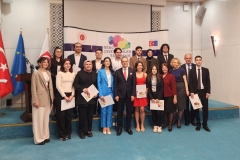
Young Translators from İzmir University of Economics Received Their Awards.
On April 16, 2024, in Ankara, the Directorate for EU Affairs hosted the Certificate Ceremony for the "Young Translators Competition," where 125
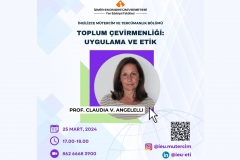
IUE Department of English Translation and Interpreting hosted Prof. Dr. Claudia V. Angelelli in the webinar titled "Community Interpreting: Practice and Ethics".
On Monday, March 25th, İzmir University of Economics Department of English Translation and Interpretation organized a webinar titled "Community Interpreting: Practice and
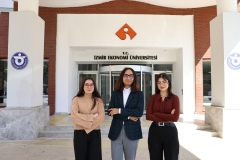
Returned to Izmir with three awards
The Young Translators Competition organized by the Ministry of Foreign Affairs Directorate for EU Affairs was marked by the success of Izmir
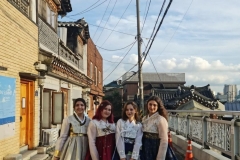
International agreements with 203 universities
Izmir University of Economics (IUE), who has signed international agreements with 203 universities with the aim of enhancing the educational opportunities offered
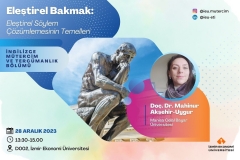
“Basics of Critical Discourse Analysis" Seminar at IUE English Translation and Interpreting Department
Izmir University of Economics, Department of English Translation and Interpreting, organized a seminar titled " Turning a Critical Eye: Basics of Critical
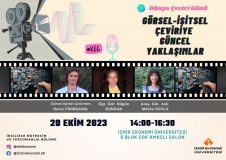
Within the framework of International Translation Day, IUE Department of English Translation and Interpreting, Faculty of Arts and Sciences, organized a panel titled "Current Approaches in Audiovisual Translation".
Within the framework of International Translation Day (September 30th), the Department of English Translation and Interpreting at Izmir University of Economics hosted
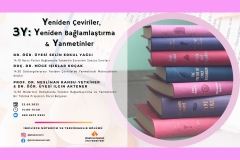
“Re-translations, Re-contextualization, and Paratexts” Panel at IUE English Translation and Interpreting Department
Izmir University of Economics, Faculty of Arts and Sciences, Department of English Translation and Interpreting organized an online panel titled "Re-translations, Re-contextualization,
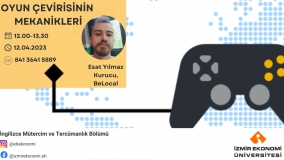
As part of the webinar series, IUE Department of English Translation and Interpreting, Faculty of Arts and Sciences, hosted Esat Yılmaz
IUE Department of English Translation and Interpreting, Faculty of Arts and Sciences, hosted Esat Yılmaz, the founder of a localization company, in



